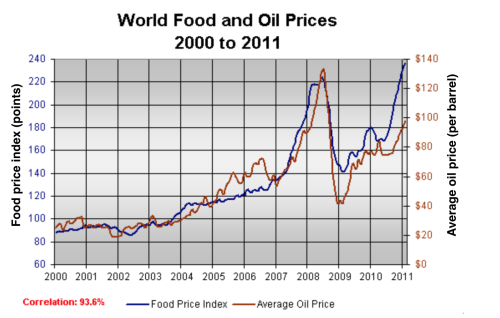[Nguyen A] Writing Practice Test 534922
Task 1
You should spend about 20 minutes on this task.
The graph below shows changes in global food and oil prices between 2000 and 2011.
Summarise the information by selecting and reporting the main features and make comparisons where relevant.
You should write at least 150 words.

The chart given illustrated data in international food and oil prices from 2000 to 2011.
In general, both prices witnessed many variations during a 12-year period. The greatest fluctuations were recorded from the middle of 2008 to early 2009.
To begin with, the food price index started at 80 and did not show any huge changes till 2007. 2 years after witnessed a sharp increase by around 100 in the foodstuffs price statistics. However, from mid-2008, this index suddenly went down to 140 in 2009. After that, it tended to rise again and reached the number 240 in 2011.
On the other hand, the oil prices were around $25 per barrel in 2000. It also had not changed much for 5 years after. The oil price statistics strongly grew and peaked at around $130 in mid-2008 despite a decrease at the end of 2006. Nonetheless, like the food price index, the average oil price declined considerably to $40 right after hitting its ceiling. Though, it began to go up again and owned an increase by $60 at the end of the period.
Task 2
You should spend about 40 minutes on this task.
Write about the following topic.
Some teachers think that international student exchange would be beneficial for all teenage school students.
Do you think its advantages will outweigh the disadvantages?
Give reasons for your answer and include any relevant examples from your own knowledge or experience.
You should write at least 250 words.

In recent years, globalization has become a general trend in the world. As a result, the demand for undergoing other educations has risen, leading to the introduction of the international student exchange. Although there are controversial opinions about the pros and cons of exchanging students, I agree with the idea that this is supposed as a good trend and creates many chances for all school learners.
The opponents claim that studying abroad may cause the risk of preferring other countries than their hometowns. Consequently, those students will immigrate to different nations, resulting in a reduction of the intellectual workforce. However, in my opinion, joining the global student exchange is the choice of each nation and individual. If a country is willing to send its learners to others, it enacts proper policies and priorities to attract those pupils to come back and devote themselves to their hometown.
On the other hand, external student exchange brings about the possibility for teenage pupils to go abroad. They will be able to experience a novel and different culture and education, which really benefits in broadening their horizons. They also have chances to access new teaching methods and techniques in developed countries. Besides, as exchange learners have to live far from their families, this contributes to making them become more independent and improve skills such as money management, time-controlling, self-reliance, and so on.
In conclusion, international student exchange is actually useful and encouraged by most students, especially by those who engage in innovation and challenges. With the above reasons, I strongly believe that its benefits outweigh the drawbacks.
Community’s feedback
Sorry! We couldn't find any contents.



